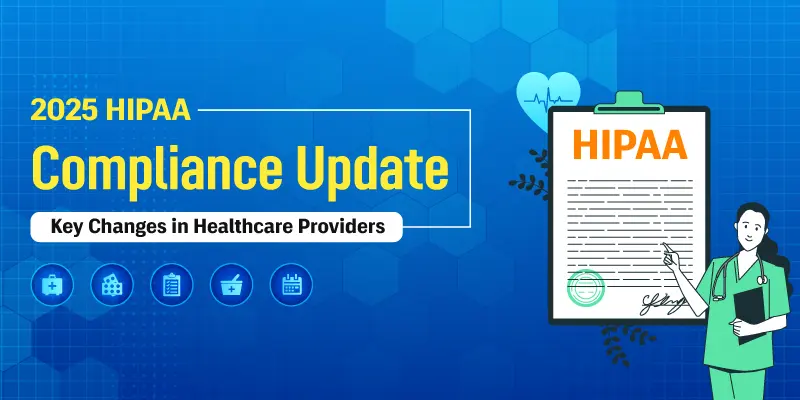
HIPPA compliance is pivotal for protecting patient information and ensuring data security in healthcare. The 2025 update is the major revision in over a decade, aiming to improve cybersecurity for electronic Protected Health Information (ePHI) due to increasing cyber threats. The proposed rule, published on January 6, 2025, has a comment period open until March 7, 2025. It introduces new requirements and builds up existing ones to address compliance gaps.
Healthcare providers must stay updated on the changes to avoid potential penalties and secure patient data. The new regulations emphasize stricter security measures, they require organizations to enhance their IT infrastructure and implement more robust risk management strategies. Compliance with these updates is essential to ensure a secure and resilient healthcare system.
This Blog covers key IT-related updates to the HIPAA Security Rule, their importance for healthcare providers, and the impact of past cyberattacks on the industry.
HIPPA (Health Insurance Portability and Accountability Act) was passed in 1996 to protect private health information. It ensures the confidentiality, availability, and integrity of ePHI. HIPPA applies to healthcare providers, health plans, clearinghouse, and their business associates who handle ePHI.
The Enforcement Rule establishes penalties for non-compliance and outlines investigation procedures. Compliance with HIPAA is very important to avoid heavy fines, legal consequences, and reputational damage. Organizations must implement administrative, physical, and technical safeguards to ensure HIPAA compliance and protect patient data effectively.
Key HIPAA Rules:
The 2025 HIPPA updates introduce stricter security measures to counter cyber attacks. The U.S. Department of Health and Human Services (HHS) expects these changes to reduce breaches and their impact. While implementation is estimated to cost $34 billion over five years, even a small reduction in breaches will justify the expense.
Healthcare providers must adopt these changes to comply with the law and protect their systems from cyber-attacks. Non-compliance can lead to heavy fines, operational disruptions, and reputational damage. The more important thing is that breaches can risk patient safety, making cybersecurity a top priority.
To stay accommodating, healthcare organizations should follow these seven steps:
1. Implement Policies & Procedures: Set documented rules and guidelines for handling Patient Health Information (PHI). These guidelines should have certain rules that tell your employees how to protect data.
2. Appoint Compliance Officer: Select someone efficient in handling the organization and ensure that it follows HIPAA rules. This person can supervise the Compliance Committee, which makes sure everyone in your organization follows this set of rules.
3. Conduct Effective Training: Always make sure your employees have clear knowledge of HIPAA and how to keep patient information safe. Instruct them so they can understand the rules and their importance.
4. Develop Lines of Communication: Establish a clear connection with your employees to ask questions or report concerns about HIPAA compliance. Encourage open communication within your organization.
5. Regular Monitor & Audit: Regularly check and review whether your organization is following HIPAA rules correctly or not. It will help in catching any problems early and fixing them.
6. Enforce Standards: Ensure everyone in your organization is aware of the consequences of not following HIPAA rules. Make known the penalties or punishment for violating these rules
7. Swift Corrective Action: If you discover that a person in your organization didn’t follow HIPAA rules, take action to fix the problem and prevent it from repeating. Address any violations as soon as you find out about them.
By following these steps, healthcare providers can ensure compliance and better protect patient data.

Ensuring compliance with HIPPA regulations requires ongoing effort. Healthcare providers should take a proactive approach by:
Cyberattacks on healthcare systems have increased, threatening patient data and critical services. In 2024 alone, 677 major health data breaches affected over 182.4 million people, causing financial losses, reputational harm, and threats to patient safety. These breaches highlight the vulnerability of the healthcare sector to cyber threats, making security a top priority.
Some of the significant breaches include the 2017 Wanna Cry ransomware attack that disrupted the UK’s NHS, while the 2019 American Medical Collection Agency breach exposed 25 million records. A more recent example is the 2023 Change Healthcare attack that paralyzed medical billing systems, severely impacting operations.
These incidents highlight the need for strong cybersecurity. The 2025 HIPPA updates aim to prevent similar breaches with stricter security requirements.
The 2025 HIPAA updates introduce a series of enhanced security measures designed to strengthen the protection of patient health information. As cybersecurity threats continue to evolve, the healthcare industry must adopt stricter compliance standards to safeguard sensitive medical data.
These updates focus on improving data security, tightening access controls, ensuring faster breach notifications, conducting comprehensive risk assessments, and granting patients greater control over their personal health information. By implementing these changes, healthcare organizations can better protect patient privacy and maintain compliance with federal regulations.
The new regulations require healthcare organizations to adopt stronger encryption methods and cybersecurity protocols to safeguard electronic health records (EHRs) and other sensitive patient information. With an increase in cyberattacks targeting healthcare systems, these measures ensure that data remains secure even in the event of a breach. Organizations are expected to use advanced encryption technologies, multi-factor authentication, and intrusion detection systems to enhance overall security.
To reduce the risk of unauthorized data access, the updated rules enforce more stringent access controls within healthcare organizations. Only authorized personnel with a valid reason will be permitted to access patient records. Role-based access control (RBAC) systems will be widely implemented, ensuring that employees only have access to the data necessary for their specific job functions. This minimizes the chances of data misuse, whether intentional or accidental.
Under the updated HIPAA Security Rule, healthcare organizations must report security breaches more quickly. Previously, organizations had a longer timeframe to notify authorities and affected individuals. The new regulations shorten this window, ensuring that breaches are addressed swiftly. Faster breach notifications allow authorities and organizations to take immediate action, potentially reducing the impact of a data breach on patients and preventing further unauthorized access.
Healthcare providers and their business associates are now required to conduct more frequent and thorough risk assessments. These assessments help identify vulnerabilities in their IT infrastructure, data storage systems, and cybersecurity defenses. By proactively addressing security gaps, organizations can strengthen their defenses against cyber threats, ensuring ongoing compliance with HIPAA regulations. The new guidelines emphasize the need for continuous monitoring, regular security updates, and staff training to maintain a high level of data protection.
Patients will now have greater authority over their health data. The updates introduce enhanced rights for individuals to access, manage, and control how their information is shared. This includes the ability to request digital copies of their medical records and set restrictions on the use and disclosure of their health information. By giving patients more control, HIPAA aims to promote transparency and strengthen trust between individuals and healthcare providers.
These updates help healthcare organizations build up strong security and protect patient data.
Healthcare providers need strong security solutions to protect patient data from cyber-attacks. AI-powered systems help by detecting risks in real time and stopping breaches before they happen. These smart tools monitor networks, spot unusual activity, and respond quickly.
Protecting devices and networks is also important. Advanced security software blocks cyber-attacks, while a zero-trust approach ensures that only authorized users can access sensitive information. It reduces the risk of insider threats and keeps patient data safe.
Strict access controls add another layer of protection; only approved staff can view or change important records. Extra security measures such as multi-factor authorization help prevent unauthorized access.
Strong backup and recovery plans ensure healthcare providers can restore data quickly and offer a cyberattack. Regular backups and encrypted storage keep patient information safe. By using AI, strong security software, and backup systems, healthcare providers can stay secure and follow HIPAA rules.
The 2025 HIPAA update will significantly enhance healthcare data security. With rising cyber threats, organizations must take proactive steps to abide by these new rules. Using encryption, multi-factor authentication, and regular audits will reduce risks and enhance security.
Navigating these updates can be complex, but working with a Managed Service provider (MSP) can simplify compliance. Staying ahead of regulatory changes helps healthcare providers protect patient data and maintain trust in the digital world.
By integrating the latest security measures and maintaining compliance, healthcare organizations can create a safer environment for both patients and providers, ensuring that sensitive data remains protected from evolving cyber threats.
Content Writer



